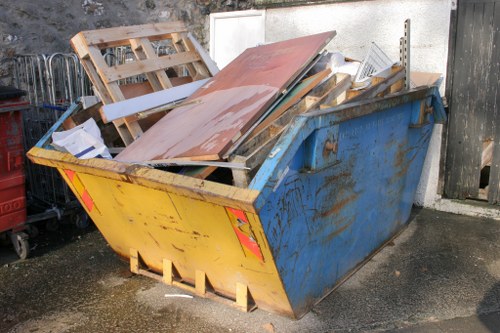Site Clearance in Wallington: Efficient and Professional Services

When undertaking construction or renovation projects in Wallington, one of the essential first steps is site clearance. Proper site clearance ensures that the area is free from debris, unwanted structures, and any potential hazards, paving the way for a smooth and efficient construction process.
Site clearance involves various tasks, including the removal of vegetation, demolition of existing buildings, and debris disposal. Hiring professional site clearance services in Wallington can save time, ensure compliance with local regulations, and promote safety on the site.
Understanding the scope and process of site clearance is crucial for project planning. This comprehensive guide explores the key aspects of site clearance in Wallington, helping you make informed decisions for your construction projects.

What is Site Clearance?
Site clearance is the initial phase of any construction or development project. It involves preparing the land by removing obstacles, debris, and any structures that may interfere with the new construction.
Key activities in site clearance include:
- Vegetation Removal: Clearing trees, shrubs, and other plant life that may obstruct construction.
- Demolition: Taking down existing buildings or structures that are no longer needed.
- Debris Disposal: Safely removing and disposing of construction waste and debris.
- Ground Leveling: Ensuring the land is level and ready for foundation work.
Proper site clearance not only prepares the land for construction but also ensures that the project adheres to environmental and safety standards.

Why Choose Professional Site Clearance Services?
Opting for professional site clearance services in Wallington offers numerous benefits:
- Expertise: Professionals have the knowledge and experience to handle various site conditions efficiently.
- Equipment: Access to specialized machinery and tools ensures that site clearance is performed effectively.
- Compliance: Professionals are well-versed in local regulations and ensure that all clearance activities comply with legal requirements.
- Safety: Trained personnel follow safety protocols to minimize risks during site clearance operations.
By choosing experts, you can avoid potential delays, reduce costs, and ensure that your project starts on the right footing.

Steps Involved in Site Clearance
1. Site Assessment
The first step in site clearance is a thorough assessment of the site. This involves evaluating the land, identifying existing structures, vegetation, and any potential obstacles that need to be addressed.
2. Obtaining Permits
Before commencing site clearance activities, it's essential to obtain the necessary permits from local authorities. This ensures that the clearance work adheres to regulatory standards.
3. Vegetation Removal
Removing unwanted vegetation is crucial to prevent interference with construction activities. This step includes clearing trees, shrubs, and other plant life.
4. Demolition
Existing structures that are no longer needed are demolished safely and efficiently. This process requires careful planning to avoid damage to the surrounding areas.
5. Debris Disposal
All debris generated during site clearance is collected and disposed of responsibly. This may involve recycling materials or transporting waste to designated disposal sites.
6. Ground Leveling
Ensuring that the land is level and properly graded is vital for the stability of the foundation. This step prepares the site for the subsequent construction phases.

Benefits of Effective Site Clearance
Effective site clearance offers several advantages:
- Time Efficiency: Streamlined clearance processes help keep the project on schedule.
- Cost Savings: Prevents unexpected expenses related to site issues that could arise from inadequate clearance.
- Enhanced Safety: Reduces the risk of accidents by eliminating potential hazards on the site.
- Regulatory Compliance: Ensures that all clearance activities meet local environmental and safety regulations.
By prioritizing site clearance, project managers can mitigate risks and set a solid foundation for successful construction.

Environmental Considerations
Site clearance must be performed with a keen awareness of environmental impact. This includes:
- Tree Preservation: Retaining trees that are essential for ecological balance.
- Waste Management: Implementing recycling practices to minimize landfill waste.
- Soil Protection: Preventing soil erosion and degradation during clearance operations.
By addressing environmental concerns, site clearance contributes to sustainable construction practices.

Choosing the Right Site Clearance Company in Wallington
Selecting a reputable site clearance company is critical for project success. Consider the following factors:
- Experience: Look for companies with a proven track record in site clearance projects.
- Equipment: Ensure the company has the necessary tools and machinery for efficient clearance.
- Licensing and Insurance: Verify that the company holds the required licenses and insurance coverage.
- Customer Reviews: Check testimonials and feedback from previous clients to gauge reliability.
- Environmental Practices: Choose companies committed to environmentally responsible clearance methods.
Making an informed choice ensures that your site clearance needs are met professionally and effectively.

Cost Factors in Site Clearance
The cost of site clearance in Wallington can vary based on several factors:
- Site Size: Larger sites require more time and resources, increasing costs.
- Vegetation Density: Heavily vegetated areas may necessitate specialized equipment and additional labor.
- Accessibility: Difficult-to-reach sites may incur higher transportation and operational costs.
- Waste Disposal: The type and amount of debris influence disposal fees.
- Permitting Fees: Obtaining necessary permits can add to overall expenses.
Obtaining detailed quotes from multiple service providers can help you budget effectively for site clearance.

Safety Measures in Site Clearance
Safety is paramount during site clearance operations. Implementing proper safety measures includes:
- Protective Equipment: Ensuring all workers wear appropriate gear, such as helmets and gloves.
- Training: Providing comprehensive training to staff on safe clearance practices.
- Hazard Identification: Assessing the site for potential dangers before commencing work.
- Emergency Protocols: Establishing clear procedures for handling accidents or incidents.
Adhering to safety standards minimizes the risk of accidents and ensures a secure working environment.

Innovative Techniques in Modern Site Clearance
Advancements in technology have introduced innovative techniques in site clearance:
- Mechanical Demolition: Utilizing machinery for efficient building dismantling.
- Controlled Explosions: Employing precision blasts for safe demolition of large structures.
- Recycling and Reuse: Implementing processes to recycle materials and reduce waste.
- GIS Mapping: Using geographic information systems to plan and execute clearance activities.
Incorporating these techniques enhances the efficiency and effectiveness of site clearance operations.

Regulatory Compliance
Compliance with local regulations is essential in site clearance. This involves:
- Environmental Laws: Adhering to guidelines that protect natural resources and ecosystems.
- Building Codes: Ensuring demolition and clearance practices meet safety standards.
- Waste Management Regulations: Following protocols for the disposal and recycling of debris.
Staying compliant not only avoids legal issues but also promotes responsible construction practices.

Post-Clearance Site Preparation
After site clearance, preparing the land for construction is the next critical step. This includes:
- Soil Testing: Analyzing soil composition to determine suitability for foundations.
- Ground Stabilization: Implementing measures to ensure the ground can support construction.
- Drainage Planning: Designing effective drainage systems to prevent water accumulation.
Proper site preparation ensures that the construction phase proceeds smoothly and efficiently.

Case Studies: Successful Site Clearance Projects in Wallington
Project A: Residential Development
A residential project in Wallington required extensive site clearance, including the demolition of an old building and the removal of dense vegetation. Utilizing mechanical demolition and efficient waste management practices, the project was completed ahead of schedule, allowing construction to begin promptly.
Key Takeaways:
- Effective planning and execution can expedite the clearance process.
- Using the right machinery enhances efficiency.
Project B: Commercial Complex
Clearing a site for a new commercial complex involved navigating strict environmental regulations. The site clearance team employed GIS mapping and controlled demolition techniques to ensure minimal environmental impact while adhering to all regulatory requirements.
Key Takeaways:
- Innovative techniques can aid in regulatory compliance.
- Environmental considerations are integral to site clearance.
These case studies demonstrate the importance of professional site clearance services in achieving successful construction outcomes.

Future Trends in Site Clearance
The field of site clearance is evolving with emerging trends:
- Automation: Incorporating automated machinery for more precise and efficient clearance operations.
- Sustainability: Emphasizing eco-friendly practices and sustainable waste management.
- Data Analytics: Utilizing data-driven approaches to optimize clearance processes.
- Advanced Safety Protocols: Implementing enhanced safety measures to protect workers and the environment.
Staying abreast of these trends can lead to more effective and responsible site clearance practices.

Conclusion
Site clearance in Wallington is a critical step in the construction process, setting the foundation for successful projects. By understanding the comprehensive steps involved, the benefits of professional services, and the importance of regulatory compliance, you can ensure that your construction endeavors proceed smoothly and efficiently.
Investing in quality site clearance services not only enhances project timelines but also promotes safety and sustainability. Whether you're embarking on a residential, commercial, or industrial project, prioritizing site clearance is essential for achieving your construction goals.
Contact us today to book your site clearance service and ensure your project starts on the right path!